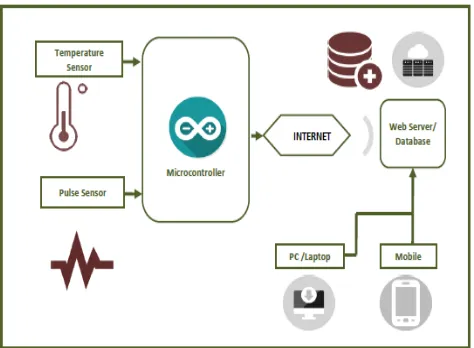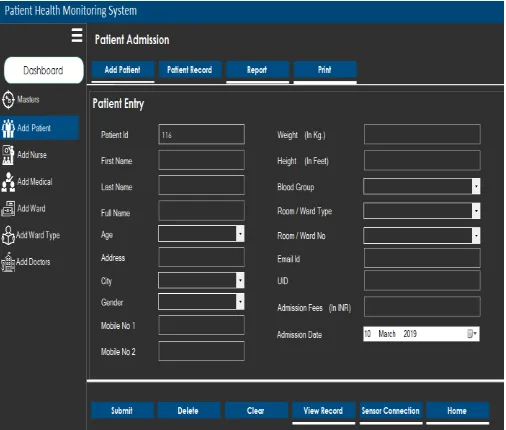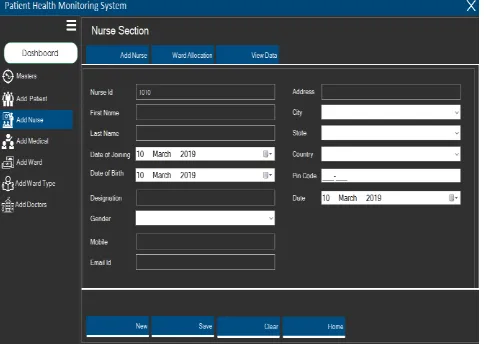DOI : 10.32628/CSEIT1952167
Design and Implementation of Health Monitoring System for Patient using
Wireless Sensor Network
Prof. Parwani Dhote1, Vaishnavi Deshpande2, Ashwini Thakre2, Mayuri Gaikwad2, Samruddhi Patil2 1Assistant Professor, Department of Computer Science and Engineering, Rajiv Gandhi College of Engineering
and Research, Nagpur, Maharashtra, India
2BE Students, Department of Computer Science and Engineering, Rajiv Gandhi College of Engineering and
Research, Nagpur, Maharashtra, India ABSTRACT
Adequate health care services and doctors are often unavailable in rural and remote areas and this problem is expected to grow worse in near future. “Patient health monitoring system using wireless sensors” objective is to provide essential medical services online to users irrespective of their location. The system offers mobile support to facilitate faster using sophisticated medical equipments in emergency cases. The daily records are also maintained so that drugs are dispatched in a proper way. The proposed health monitoring system consists of four modules: 1) Doctor module, 2) Patient module, 3) Nurse module and 4) Admin module. For the successful execution of modules sensors are being used. The sensors used are namely temperature sensor, heartbeat sensor and blood pressure sensor. This system will work on basically three algorithms namely KNN algorithm, semantic matching algorithm and data distribution algorithm. This system helps to overcome time and memory required to a great extent. The sensors used in the system are developed using low-power dedicated sensor arrays for temperature and movement. It also resolves the issue of inaccurate results.
Keywords : Health Monitoring System, Wireless Sensor Network, KNN, TMP
I. INTRODUCTION
Wireless sensor network achieves environment monitoring and controlling through use of small devices of low cost power. Such network is comprised of several sensor nodes, each having a microprocessor, sensor and wired/wireless transceiver inside a small device. The sensor nodes provide intelligence information and useful services for common human life through negotiation with their adjacent nodes. Wireless sensor networks can be adjusted widely in application fields such as medical care, military tactics, home networking , environment monitoring and so on. This system is providing reliable and fast medical services for
patients by transmitting reports to doctors, nurses and other caregivers.
II. LITERATURE SURVEY
nurse module and doctor module. The inputs from these sensors are read by the microcontroller and are send to the web server through internet. From the web server the doctor can view the current values and according to inputs doctor can prescribe suitable medicines. The above approaches lack to work in the absence of doctor. Hence, we propose a system which can not only monitored patient’s health but also can immediately diagnose with appropriate medication.
III. PROPOSED APPROACH
The approach of patient health monitoring system is that to have sensors such as temperature sensor, blood pressure sensor and pulse rate sensor. The inputs from these three sensors are read by the microcontroller or the arduino uno board. Then via Internet these inputs are send to the web server. Using the respective web server the inputs are viewed on the PC/laptop and mobile after the connection with the web server.
Fig 1 : System Architecture of Patient Health Monitoring System
The patient health monitoring system is briefly divided into three sections -
1. Hardware Requirements
As the system uses sensors so firstly we require blood pressure and temperature sensor and then we require the converters and cables. The hardware requirement is specified below –
• Blood Pressure Sensor – Serial Output
• Temperature Sensor – TMP36
• Arduino Uno
• USB to TTL UART RS232 Serial Converter Module PL2303HX+AU
• Male-to-Male Jumper Ribbon Cable
• 9DC100 9 Volt Power Adaptor
• USB data cable
2. Hardware implementation
The patient health monitoring system requires some kind of hardware as wireless sensors are used. The sensors used are namely temperature sensor , pulse rate sensor and blood pressure sensor. The brief details about these sensors are given below-
1] Temperature Sensor- TMP 36
The temperature sensor being used is named as TMP 36. TMP 36 is a low voltage, precision centigrade temperature sensor. It provides a voltage output that is linearly proportional to the Celsius temperature. It just needs a ground and a 2. 7 to 5. 5VDC and reads the voltage on the Vout pin. This sensor is easily
available as it is a non-industrial sensor.
2] Blood Pressure and pulse rate Sensor – Serial Output
device is an industrial device so it is given more preference as it is easy to operate and has a switching button to start, fully automatic and it has clinical accuracy as well.
In order to transfer and receive the values of the sensors there is a need of a microcontroller. The brief details are given below-
3] Arduino Uno
The arduino uno is a microcontroller board based on the ATmega328 (datasheet). The board has 14 digital input/output pins, 6 analog inputs, a 16MHz ceramic resonator, USB connection , a power jack, an ICSP header and a reset button. The Arduino Uno differs from all the preceding boards as in that it does not use FTDI USB-to-serial driver chip.
IV.RESULTS AND DISCUSSION
Working of Web portal
The working of web portal is divided in four phases -
Phase 1: Patient Registration
As soon as we enter the web portal we get an authentication access page in which there are two options patient admission (specifically handled by administrator only) and nurse section. In the authentication access page if we select the patient admission section so it pops a page where the administrator (receptionist) needs to enter the user id and password. After the patient admission login, an dashboard is displayed in which the count of wards, doctors, patients is given. The left side of the dashboard shows various options such as masters, add patient, add doctors and so on. The masters option will show the blood group, city ,state and other general information of the patients. In the add patient option the patients who are being admitted are registered. The patient admission form consists of
patient id , first name, last name, age , address , city, mobile number (two mobile numbers) , some general medical information such as weight(in kg), height(in feet), blood group, email id ,aadhaar card number and they have to choose the ward type from the drop down menu whether they want general ward or ac ward. After the form is filled they have to save it and the administrator can view the full information of the patient in the patient record menu.
Fig 2: The Patient Registration Page
Phase 2: Nurse Registration
ward is allocated to the nurse a unique username and password is generated for the nurse so that the nurse can login directly into the nurse section. The username and password is sent to the nurse via the messaging service on the mobile number given by the nurse. And this user id and password can be viewed by the nurse on her mobile phone and the administrator. As the nurse is allocated a ward she must have all the details of the patients in her ward so for that view data option is created. In the view data option, the nurse has to select the ward first and then the information of only those patients in that particular ward is displayed.
Fig 3 : Nurse Registration Page
Phase 3: Sensor Connection
As soon as sensors are connected by the nurse to the patient’s body the nurse will click on the sensor connection option available on the patient admission page. After that a hardware communication page is displayed in which there is selection of the communication port according to the computer hardware system. This selection of the communication port is for the body temperature sensor particularly. Then click on the connect button. The output of the body temperature is displayed on the same page within a time span of 10 seconds. For the output of the blood pressure sensor, click on the connect BP sensor option available on the same page. After doing this, another hardware communication
page is displayed in which also the selection of communication port is required and then click the connect button. The output of the blood pressure cum the pulse rate is displayed in the systolic, diastolic and pulse rate boxes respectively. For the nurse to view all the outputs together she has to click on the get data option in the hardware communication page of the BP sensor. The outputs are shown in the patient diagnosis page in which the general information as well the current or runtime outputs taken are viewed both in text and label form.
Fig 4: Connection of body temperature sensor
Fig 5: Connection of blood pressure sensor
Phase 4: Prescription Generation
patients name and the prescription is viewed defining the medicines, dosage of the medicine and the timings.
Fig 6: Generated Prescription
V.CONCLUSION
This system helps to overcome time and memory required to a great extent. The system also helps to resolve the issue of inaccurate results. The system uses sophisticated medical equipments to facilitate faster in emergency cases. Each and every patient’s record is maintained in systematic manner in order to make the searching process easier. Also, it establishes a real-time communication between the patient and the doctor.
VI.REFERENCES
[1]. Udit Satija, Barathram Ramkumar, M. Sabarimalai Manikandan, “Real-Time Signal Quality-Aware ECG Telemetery System for
IoT- Based Healthcare Monitoring”. In IEEE Internet of Things J. , vol. 2, No. 1, pp. 72-83, February 2015.
[2]. Purnima Puneet Singh, “Zigbee based Centralised Patient Monitoring System”, Computational Intelligence and Communication Networks (CICN) 2015 International Conference on, pp. 212-217, 201. [3]. Deepesh K. Rathore, Ankita Upmanyu and
Deepanshu Lulla, “Wireless Patient Health
Monitoring System”, In International
Conference on Information Acquisition, Print ISBN: 0-7803-9303- 1, June 27 - July 3 2005. [4]. B. Vijayalaxmi, C. Ram Kumar, “Patient
Monitoring System Using Wireless Sensors based Mesh Network”, IEEE Communication Magazine, 2005, Yol. 43(9), 23-30.
[5]. Se-Jin Oh, Chae-Woo Lee, “u-Healthcare Sensor Grid Gateway for connecting Wireless Sensor Network and Grid Network”, in IEEE, Aug 2002.
[6]. Fran Berman, Geoffrey Fox, Anthony J. G, "Grid Computing: Making The Global Infrastructure a Reality," Wiley, April 2003. [7]. Ian Foster, Carl Kesselmna, "The Grid 2:
Blueprint for a New Computing Infrastructure,," Morgan Kaufmann, Nov. 2003. [8]. N Jacq, C Blanchet, C. Combet, E Cornillot, L Duret, "Grid as a bioinformatics tool,," Parallel Computing, Elsevier, pp. 1093-1107, July 2004. [9]. J Pitt-Francis, A Garny, D Gavaghan "Enabling
computer models of the heart for high-performance computers and the grid. ", Philosophical transactions Apr. 2006.
[10]. Z Shen, J Luo, G Huang, D Ming, W Ma, H Sheng, "Distributed computing model for processing remotely sensed images based on grid computing," Information Science , vol. 177, pp. 504-518, 2007.
care,," In Proc. MobiSys 2004 Workshop on Applications of Mobile Embedded Systems, June 2004.
[12]. G. Virone, A. Wood, L. Selavo, Q. Cao, L. Fang, T. Doan, Z. He, and J. Stankovic, "An advanced wireless sensor network for health monitoring," In Transdisciplinary Conference on Distributed Diagnosis and Home Healthcare (D2H2), April 2006.
[13]. H. Huo and Y. Xu, “An Elderly Health Care System Using Wireless Sensor Networks at Home”. Third International Conference on Sensor Technologies and Applications. Sensor comm, pp. 158-163, 2009.
[14]. D. Benhaddou, M. Balakrishnan, and X. Yuan,
“Remote Healthcare Monitoring System
Architecture using Sensor Networks”, Region 5 Conference, July, 2008 IEEE, dio: 10. 1109/TPSD. 2008. 4562760.
[15]. J. Choi, S. Yoo, H. Park, and J. Chun, “Mobile Med: A PDA-Based Mobile Clinical Information System”. Information Technology In Biomedicine, IEEE Transactions. Volume 10, Issue 3, pp. 627 - 635, July 2006.
Cite this article as :


